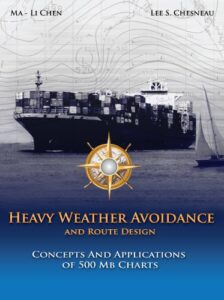Heavy weather at sea is a deadly serious and always relevant safety issue, as inappropriate manipulations in such conditions may lead to damage of a vessel, threatening the cargo, the environment or, even worse, human life.
 A book, entitled ‘Heavy Weather Avoidance and Route Design: Concepts and Applications of 500 Mb Charts’, is combining the knowledge of a Captain with that of a senior meteorologist, to address this always imminent safety risk and become a fit-for-purpose guide to safe navigation.
A book, entitled ‘Heavy Weather Avoidance and Route Design: Concepts and Applications of 500 Mb Charts’, is combining the knowledge of a Captain with that of a senior meteorologist, to address this always imminent safety risk and become a fit-for-purpose guide to safe navigation.
Written by Capt. Ma-Li Chen, a Master Mariner with years of experience, and Lee S. Chesneau, a meteorologist with decades of experience in analyzing and forecasting weather, the book comes to explain what actually goes on in the atmosphere and on the sea’s surface.
Using a readable text brimming with useful graphics from start to finish, the authors are getting to the point without wasting time: They emphasize on the root cause of how and why bad weather develops and where it is likely to go.
As an interesting combination of two knowledge fields, the book also attempts to demystify the 500 Mb chart, a useful weather tool for mariners, serving in this way as a valuable reference for both typical mariners and recreational sailors on the 500 Mb chart and its relevance to surface weather.
Divided into an ideal proportion of theory and practice, the book firstly enables the reader to get a feel for how air mass energy transfer works, defining the atmosphere in three dimensions.
Moving in a more practical aspect, the book seeks to give mariners an entirely new way of looking at 500 Mb charts and, even more, help them acquire a new level of expertise on more practical self-forecasting and storm avoidance.
In this regard, Heavy Weather Avoidance and Route Design acts as not only as a well-written guide for anyone who has an interest in being able to determine the weather in advance, but even more it serves as a valuable contribution to shipboard weather routing.
Preventing heavy weather damage: Key actions
- If cargo onboard, to be loaded as per Cargo Security Manual
- The vessel speed needs to adjust with the course and slow down if needed
- Consideration is needed of the actual stability conditions
- Lashing equipment or hatch covers and seals must be in a good condition
- Officers must be well trained to handle potential risks
- Alternate routes should be available.






























































